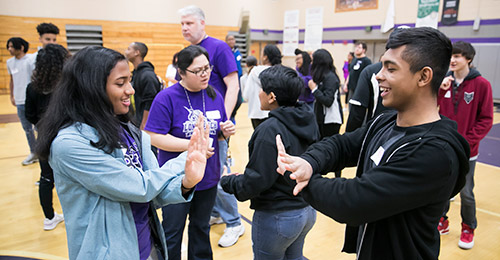Building Positive Schools and Healthy Relationships
May 23rd, 2018

HCPSS is committed to providing a nurturing school culture, so every student can feel supported and thrive. Restorative justice as a philosophy is guiding these efforts, as it emphasizes building healthy relationships between students and school staff, as well as among adults within the community. Restorative practices are already in use at many HCPSS schools, and the system is working to expand the practices into all schools under the guidance of the Department of Diversity, Equity and Inclusion.
“Restorative justice is the next wave of education. We need to do our best work in how we interact with young people and their families,” HCPSS Director of Diversity, Equity and Inclusion Kevin Gilbert said. “By taking care of socio-emotional needs, we can unlock students’ minds to have the academic successes we want them to have.”

Schools participating in restorative practices, when rooted in restorative justice, can better support students’ social and emotional development and create safe spaces for difficult conversations, deep emotions and healing. Restorative practices take shape in Howard County schools through a range of techniques–from informal conversations to get to know one another to more formal conferences addressing behavioral issues. Likewise, HCPSS empowers students with Student Voice opportunities, enabling them to express themselves and make an impactful difference on issues that affect their schools and communities. In turn, negative responses like bullying, suspensions and office referrals can then be reduced.
Homewood Center was the first HCPSS school to embark on restorative work six years ago. Homewood Principal Christina Krabitz explains, “You have to be intentional every day to be restorative. The building feels like family, but it’s a constant journey to stay there. It’s about how we speak to each other and our students, having humanistic interactions and being partners with our students.”
What started out as a tool to resolve a specific incident at Homewood has been embraced as a schoolwide initiative that has shifted the entire culture of the building. Homewood has seen much success by focusing on community building through regular class circle conversations, among other activities. Since starting restorative work, from school year 2011-12 to the present, attendance has increased by at least 14 percent, and office referrals and out-of-school suspensions have decreased by 80 percent and 55 percent, respectively.

Restorative practices are also getting positive results at schools newer to the approach. For example, Oakland Mills Middle School is in its second year of implementing restorative practices and has seen a 75 percent reduction in out-of-school suspensions this school year in comparison with last. Additionally, many students who previously struggled with behavioral issues took part in restorative circles and had a significant decrease in repeat conflicts.
Restorative justice as a philosophy naturally weaves into HCPSS’ core values and current initiatives, most notably the school system’s Strategic Call to Action, Learning and Leading with Equity, which strives to ensure the academic success and social-emotional well-being of each student in an equitable and warm environment.

HCPSS’ efforts in creating nurturing school cultures are also supported by the multi-tiered systems of supports used by student support teams and instructional intervention teams, and Positive Behavioral Interventions and Supports (PBIS). Currently implemented in 68 HCPSS schools, PBIS is based on the belief that by reinforcing positive behaviors, outcomes for all children improve because schools are more effective and efficient in providing instruction.
Ultimately, HCPSS aims to operate restoratively through organizational policies, practices, procedures and actions that ensure a focus on community, accountability in training and consistency of practice throughout the school system.
“It’s so refreshing that the drive of the county is on restorative and the ideas of equity, inclusion and diversity,” Krabitz said. “It’s needed for every kid, whether they are an AP student who is stressed out or someone who has behavioral issues. We’re so glad more kids will have access to the restorative approach.”
 HCPSS
HCPSS